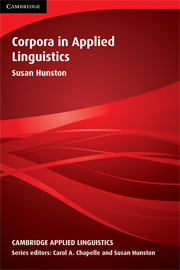Book contents
- Frontmatter
- Contents
- Series editors' preface
- Acknowledgements
- 1 Introduction to a corpus in use
- 2 The corpus as object: Design and purpose
- 3 Methods in corpus linguistics: Interpreting concordance lines
- 4 Methods in corpus linguistics: Beyond the concordance line
- 5 Applications of corpora in applied linguistics
- 6 Corpora and language teaching: Issues of language description
- 7 Corpora and language teaching: General applications
- 8 Corpora and language teaching: Specific applications
- 9 An applied linguist looks at corpora
- List of relevant web-sites
- References
- Index
6 - Corpora and language teaching: Issues of language description
Published online by Cambridge University Press: 05 October 2012
- Frontmatter
- Contents
- Series editors' preface
- Acknowledgements
- 1 Introduction to a corpus in use
- 2 The corpus as object: Design and purpose
- 3 Methods in corpus linguistics: Interpreting concordance lines
- 4 Methods in corpus linguistics: Beyond the concordance line
- 5 Applications of corpora in applied linguistics
- 6 Corpora and language teaching: Issues of language description
- 7 Corpora and language teaching: General applications
- 8 Corpora and language teaching: Specific applications
- 9 An applied linguist looks at corpora
- List of relevant web-sites
- References
- Index
Summary
The development of corpora has the potential for two major effects upon the professional life of the language teacher. Firstly, corpora lead to new descriptions of a language, so that the content of what the language teacher is teaching is perceived to change in radical ways (Sinclair 1991: 100; Stubbs 1996: 231–232). The question ‘What is language like?’ will be answered in this chapter. Secondly, corpora themselves can be exploited to produce language teaching materials, and can form the basis for new approaches to syllabus design and to methodology. These topics will be explored in the next chapter.
Language as phraseology
Introduction
In chapters 1 and 3 of this book, attention was drawn to the tendency of words to occur, not randomly, or even in accordance with grammatical rules only, but in preferred sequences. Some examples of this are:
Collocation: for example, utterly frequently occurs before different but not before similar, and before ridiculous but not before sensible.
Phrases and variation: for example, one of the uses of the noun smoke is in the phrases where there's smoke there's fire and no smoke without fire. These phrases are open to considerable creativity and exploitation, with examples such as many Americans came to believe that where there was smoke there must be fire or Sometimes there is smoke without fire. There is regularity here but not fixedness.
The tendency of certain verbs to occur in the passive rather than the active, or in the negative rather than the positive, or in the present or the past tense: for example, Manchester is hemmed in by industrial areas is more likely than industrial areas hem Manchester in; and it never entered my head to be scared is more likely than it entered my head to be scared.
The occurrence of complementation patterns: suggestion that, decision as to whether, obligation to do are examples.
- Type
- Chapter
- Information
- Corpora in Applied Linguistics , pp. 137 - 169Publisher: Cambridge University PressPrint publication year: 2002

